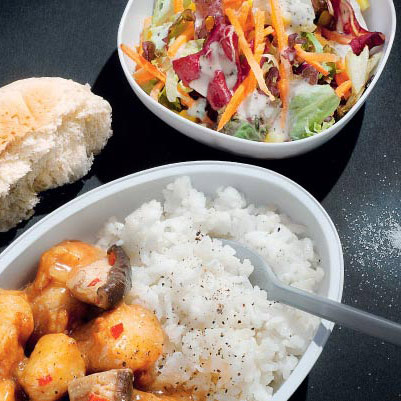Five Senses on a Plane
Aromas, appearance and even noise play into menu development on British Airways

When it comes down to it, says British Airways Height Cuisine chef Heston Blumenthal, “Eating is the only thing we do that engages all five senses.” Certainly air travel provides a challenging forum for a sensory experience, but Blumenthal and his culinary team have risen to the occasion to create the most visually appealing, delicious food possible—even at 35,000 feet.
When British Airways initially set out to evaluate their culinary program, they began at the micro level of investigation, examining the science of taste buds at high altitudes with a series of experiments. In such conditions, which are also hindered by cabin pressure and extremely low humidity, most people lose about 30% of their ability to taste food while flying. Based on their research the team worked to maximize each of the five flavors—salty, sweet, bitter, sour and umami—in thoughtful combinations on the menu, without simply adding salt or sugar.

Banishing bland and gooey meals, the team assessed the colors of food to understand how much the visual aspect enhances the meal. Partnering with the Taste of London, British Airways conducted an experiment at the festival to see what flavors people expect when eating certain colors—red, for example, being associated with strawberries or raspberries, orange with oranges, etc. The team placed a new focus on the visual interest of each dish, adding color-rich herbs that look and taste good. Presentation also comes into play when it comes to one’s expectations of a meal based on what they see, so the British Airways team incorporated a menu-design document that outlines the proper plating of dishes to ensure they look their tastiest.
According to British Airways Menu Design Manager Sinead Ferguson, noise is another, perhaps surprising, environmental factor that hinders flavor. Ferguson conducted a unique experiment in which people were served two dishes—both tiramisu—while listening to Italian music, then Indian music. The conclusion: people were more inclined to focus on the music than what they were tasting. Many of the test subjects described the food completely differently, then found out it was the same dessert. The culinary team discovered that the flavors in airline meals have to compete with the noise level on the plane as well.
Perhaps most closely tied to one’s sense of taste is the sense of smell. Because the power of taste buds draw from that relationship, the impact of altitude and humidity starts to have an affect at your nose. To combat the assault on one’s olfactory capability, the BA culinary team decided to add citrus juices to add fresh acidity and brighten scents in various foods. Tom Badcock, director of the cheese program for the airline, uses his lifetime of experience to select the ideal balance of pungent cheese so that they taste great in the air, but sit well with other passengers in close quarters.
In their book The Flavor Bible Karen Page and Andrew Dornenburg describe flavor with this mathematical equation: flavor = taste + mouthfeel + aroma + “the X factor”. With a similar holistic approach to their culinary program, the team at British Airways factors in closed cabin at 35,000 feet to their menu creation for all-encompassing good meals.













